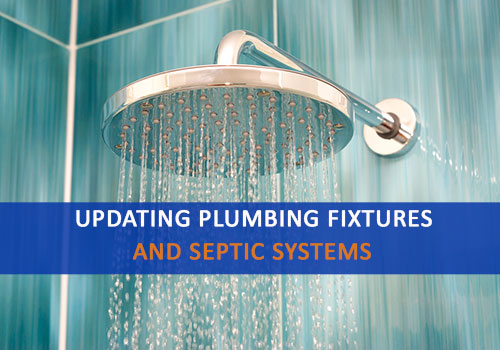Updating plumbing fixtures can be a fun way of restyling your home. Bonus points because these updates can have the added benefit of making your septic system last longer. It may sound crazy, but plumbing fixtures and appliances play a significant role in the health of your septic system.
Anytime you turn on the faucet or flush the toilet, that water flows through your plumbing pipes and out to your septic tank. From there, a natural separation occurs with help from healthy bacteria, sinking the solid wastes and expelling the liquids to the leach field.
Now let’s say your system is overloaded with an excess of water. Whether from too much laundry, running the dishwasher, or inefficient fixtures, your system has too much water. Excess in your septic system causes backups and doesn’t allow your system to treat wastewater properly.

How Do Upgrading Plumbing Fixtures Help Your Septic System?
An average household uses a lot of water, a surprising amount of water! An average home with a single-family will use about 70 gallons of water per person per day. The most significant amount of water usage comes from flushing the toilet, accounting for 25 to 30 percent of household usage, followed by showering and running faucets, which account for about 15 to 20 percent each. Also, consider other fixtures and appliances like washing machines and dishwashers that add to the household water usage. By upgrading your plumbing fixtures, you can use about 20 percent less water. That is 20 percent less water flowing into your septic system, causing less wear over time.
Water conservation is a great way to protect both the environment and your septic system. Repairing or replacing your septic system can be very expensive and time-consuming. Conserving household water can be an easy way to extend the life of your septic system. While being more conscious about the water you use is a great way to protect your system, you may want to consider upgrading your plumbing fixtures for a long-term solution.
Low-Flow Toilets
Low flow toilets, sometimes called high-efficiency toilets, can save a lot of water and therefore money for you. Older toilets will use 3.5 gallons of water with every flush. If you use the toilet even three to four times a day, that is 10 to 15 gallons of water just from flushing. High-efficiency toilets use 1.6 gallons per flush at a maximum. You can even invest in a toilet with a dual-flush system. This will only use 0.8 gallons for liquid waste flushes, saving about three gallons of water with each flush.
As far as upgrading plumbing fixtures go, a low-flow toilet is a great first step.
Faucet Aerators
A low-flow faucet aerator mixes air with your water, so less water comes out of the faucet. The benefit of an aerator is that it will not affect the water pressure while still saving about half of the water you would’ve used. Using a faucet aerator can reduce the amount of water you use by 30 percent without affecting water pressure and even improving it in some cases.
Water-Efficient Showerheads
Water-efficient showerheads can save a single-family a lot of money not just in water usage but also in the heating of the water.
Less water equals less energy needed to heat it. Your water usage can go down by 2,700 gallons per year, which means you have more water to wash your car, do lots of laundry, or save it and save some money (and your septic).
Suppose you need more incentive than just extending the life of your septic system and protecting the environment. In that case, you can save a lot of money. Your family can save almost 400 dollars per year just by upgrading your plumbing fixtures. That doesn’t account for the amount of money you will save on unnecessary repairs to an aging septic system, as well as other costs, like heating and electricity, which can be affected by water usage in your home. The step of upgrading your toilet, faucets, and showerheads to energy-efficient fixtures will pay for itself in a year or less.
Habits that Protect Your Septic System
In addition to upgrading plumbing fixtures, remember the basic septic system rules. Don’t waste water; turn the faucet off while you brush your teeth, take a shorter shower, only run a full dishwasher. Don’t flush anything other than waste and toilet paper, and use your garbage disposal sparingly.
When upgrading your plumbing fixtures, it’s a good idea to have your septic company service your septic system and make sure everything is functioning correctly so that you can move forward with a clean, healthy system. Talk to your septic company today about any questions you have about the process.

